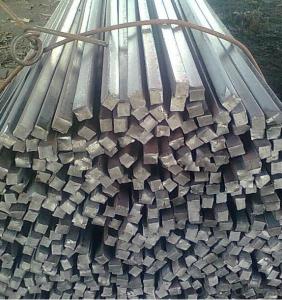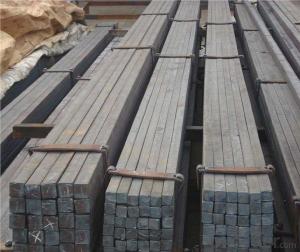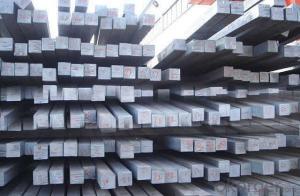Square Bar, Hot Rolled with High Qaulity
- Loading Port:
- China main port
- Payment Terms:
- TT or LC
- Min Order Qty:
- 25 m.t.
- Supply Capability:
- 10000 m.t./month
OKorder Service Pledge
OKorder Financial Service
You Might Also Like
Product Description of Square Bar, Hot Rolled with High Qaulity :
-Standard: GB,
-Grade: Q195 or equivalent.
-Chemical Composition:
Standard | Grade | Element (%) | ||||
GB | Q195 | C | Mn | S | P | Si |
0.06~0.12 | 0.25~0.50 | ≤0.050 | ≤0.045 | ≤0.30 | ||
Measures of Square Bar, Hot Rolled with High Qaulity:
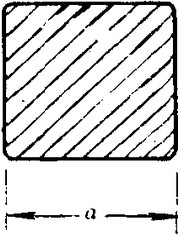 :
:
(Section of HR Square Bar)
-Length of a side and Theoretical weight of Square Bar.
Length of a side(mm) | Theoretical weight(kg/m) | Length of a side(mm) | Theoretical weight(kg/m) |
7 | 0.385 | 22 | 3.80 |
8 | 0.502 | 24 | 4.52 |
9 | 0.636 | 25 | 4.91 |
10 | 0.785 | 26 | 5.30 |
11 | 0.950 | 28 | 6.15 |
12 | 1.13 | 30 | 7.06 |
13 | 1.33 | 32 | 8.04 |
14 | 1.54 | 34 | 9.07 |
15 | 1.77 | 36 | 10.17 |
16 | 2.01 | 38 | 11.24 |
17 | 2.27 | 40 | 12.56 |
18 | 2.54 | 42 | 13.85 |
19 | 2.82 | 45 | 15.90 |
20 | 3.14 | 48 | 18.09 |
21 | 3.46 | 50 | 19.63 |
Notes:
1, The theoretical weights in the list, base on the density of 7.85 g/cm3.
2, Formula for theoretical weight of Square bar: (length of a side)2 * 0.00785
3, The numbers with *mean that they are not regular or we don’t offer them.
-Regular length of Square Bar:
Steel | Length of a side (mm) | Length of steel (m) |
Normal steel | < 25 | 4~10 |
> 25 | 3~9 | |
Steel of high quality | All measure | 2~6 |
Tool steel >75 | 1~6 |
Usage/Applications of Square Bar, Hot Rolled with High Qaulity:
-The Square Bar is normally used as structure steel.
-Row material for other structure steel like steel angles, channels, I-beams, H-beams, etc…
Packaging & Delivery of Square Bar, Hot Rolled with High Qaulity:
-Packing Detail: The products can be packed in bundles by steel wires.
-Marks: We make tag marks and color marks. The tag marks with white background and red company logo will be tied up to each bundle of the products. The information is usually including basic information of products and company and other information requested by customers. As for color marks, we will paint both ends of bundles to make sure that it will be more convenient for customers to distinguish them from other products.
-Delivery Detail: 30~45 working days after receive buyer’s T.T. or L/C.
FAQ:
Q1: Why buy Materials & Equipment from OKorder.com?
A1: All products offered byOKorder.com are carefully selected from China's most reliable manufacturing enterprises. Through its ISO certifications, OKorder.com adheres to the highest standards and a commitment to supply chain safety and customer satisfaction.
Q2: How do we guarantee the quality of our products?
A2: We have established an advanced quality management system which conducts strict quality tests at every step, from raw materials to the final product. At the same time, we provide extensive follow-up service assurances as required.
Q3: How soon can we receive the product after purchase?
A3: Within three days of placing an order, we will begin production. The specific shipping date is dependent upon international and government factors, but is typically 7 to 10 workdays.
Images:
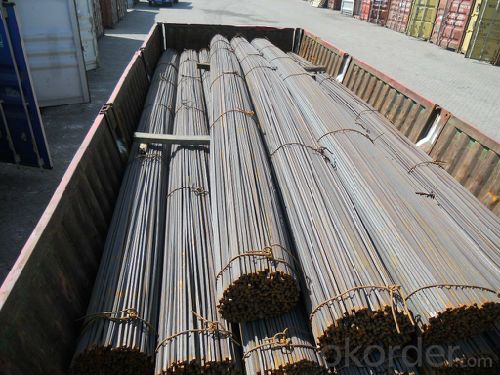
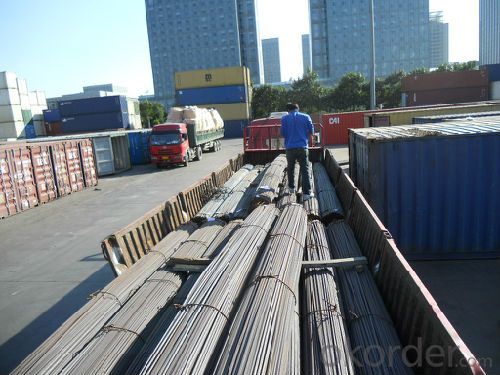
- Q:Can a steel square be used for flooring installation?
- No, a steel square is not typically used for flooring installation. Flooring installation requires specialized tools and materials such as adhesive, underlayment, and flooring nails or staples. A steel square is more commonly used in carpentry for measuring and marking angles, not for the actual installation of flooring.
- Q:What is the purpose of the tongue and groove on a steel square?
- The purpose of the tongue and groove on a steel square is to allow for precise and accurate measurements and marking in carpentry and other related fields. The tongue and groove design helps to ensure that the square remains perfectly aligned and square when in use. It allows for the square to be securely held against a flat surface or edge, providing stability and preventing any movement or slippage. This ensures that measurements and markings made using the steel square are consistent and reliable, making it an essential tool for tasks such as marking and cutting angles, checking for squareness, or laying out patterns. Additionally, the tongue and groove design also allows for easy storage and transportation of the steel square, as it can be conveniently folded and locked together, minimizing the risk of damage or misplacement. Overall, the tongue and groove on a steel square serves to enhance precision, accuracy, and efficiency in various woodworking and metalworking applications.
- Q:Can a steel square be used for marking out mortise and tenon joints?
- Yes, a steel square can be used for marking out mortise and tenon joints. A steel square is a versatile and reliable tool that is commonly used in woodworking for making accurate measurements and marking out precise angles. When it comes to mortise and tenon joints, the steel square can be used to ensure that the mortise (the hole) and the tenon (the projecting piece of wood) are cut and aligned correctly. To mark out a mortise and tenon joint using a steel square, you would start by measuring and marking the desired dimensions on the workpiece. The steel square can be used to make 90-degree angles, which are essential for accurate mortise and tenon joints. You can align the square with the edge of the workpiece and use it as a guide to draw straight lines or mark the location of the mortise and tenon. Additionally, a steel square can also help ensure that the mortise and tenon are properly aligned with each other. By using the square to check the corners and angles of the joint, you can ensure that the joint will fit together snugly and securely. In conclusion, a steel square is a useful tool for marking out mortise and tenon joints as it provides accuracy, straight edges, and helps maintain the squareness of the joint. It is a valuable tool for any woodworker looking to create strong and precise joinery.
- Q:How is a steel square used in carpentry?
- A steel square, also known as a framing square or carpenter's square, is a versatile tool that is widely used in carpentry for various purposes. It consists of two arms, typically 24 inches long, joined at a right angle. One arm is called the blade, and the other is called the tongue. One of the most common uses of a steel square in carpentry is for determining and marking right angles. Carpenters use it to ensure that corners and joints are perfectly square. By placing the square against a board or surface, they can confirm if the angles are 90 degrees. If not, adjustments can be made accordingly to ensure accuracy and precision in the construction process. In addition to checking right angles, a steel square is also used for measuring and marking cuts. The blade of the square is marked with various measurements, such as inches and centimeters, allowing carpenters to take precise measurements quickly. This helps in accurately marking the length and width of boards or pieces that need to be cut, ensuring proper fitment and reducing errors. Another application of a steel square is for laying out and marking angles other than 90 degrees. The tongue of the square is marked with degree increments, making it easy for carpenters to measure and mark angles of different degrees. This is particularly useful when working on projects that require angled cuts, such as roof rafters or staircases. Furthermore, a steel square can be used as a guide for making straight cuts with a circular saw or jigsaw. By aligning the blade of the saw against the blade of the square, carpenters can ensure a straight and accurate cut. Overall, a steel square is an indispensable tool in carpentry, providing carpenters with the ability to check right angles, measure and mark cuts, and lay out angles with precision. Its versatility and accuracy make it an essential tool for both professional carpenters and DIY enthusiasts.
- Q:How do you use a steel square to determine the correct angle for a bevel cut?
- To determine the correct angle for a bevel cut, one can utilize a steel square and adhere to the following steps: 1. Commence by positioning the steel square on the desired material to be cut, aligning one side of the square with the material's edge. 2. Adjust the square to the preferred angle for the bevel cut. This angle can be determined based on project specifications or personal preference. For instance, if a 45-degree bevel cut is desired, align the 45-degree marking on the square with the material's edge. 3. Once the square is properly set at the desired angle, employ a pencil or marking tool to create a line along the edge of the square. This line will serve as a guiding reference for the bevel cut. 4. After marking the line, remove the square and proceed with executing the bevel cut utilizing a saw or an appropriate cutting tool. It is crucial to accurately follow the marked line to achieve the intended angle for the bevel cut. By utilizing a steel square, one can rely on a trustworthy technique to determine the correct angle for a bevel cut. This method enables precise measurements and ensures accuracy in woodworking or construction projects.
- Q:How do you use a steel square to determine angles for wainscoting?
- To use a steel square to determine angles for wainscoting, there are a few steps you can follow: 1. Measure the height and width of the area where the wainscoting will be installed. This will help you determine the size and dimensions of the wainscoting panels. 2. Place the steel square against the wall, ensuring it is flush and level. The long edge of the square should be against the wall, while the shorter edge is facing outward. 3. Align one leg of the square with the bottom edge of the wall or baseboard. Keep the other leg of the square perpendicular to the wall. 4. Trace a line along the longer edge of the square using a pencil or marker. This line will serve as a reference for cutting or installing the wainscoting panels. 5. Next, measure the height of the wainscoting panels and mark it on the wall using a tape measure. This will help you determine where the top edge of the wainscoting should be. 6. Align the square with the top edge of the wainscoting mark and trace another line along the longer edge of the square. 7. By connecting the two lines you have traced, you should now have a reference angle for the wainscoting. This angle will help you determine how to cut the top and bottom edges of the wainscoting panels to fit the wall properly. 8. Repeat this process for each section of the wall where wainscoting will be installed, ensuring that the square is properly aligned and level each time. Using a steel square in this way can help you achieve precise and accurate angles for your wainscoting, ensuring a professional and visually appealing installation.
- Q:What are the markings and graduations on a steel square used for?
- The utilization of the markings and graduations on a steel square encompasses a multitude of purposes within the realm of carpentry and its related fields. In the first place, these markings serve the function of measuring and delineating specific lengths on the material undergoing manipulation. It is customary for the square to possess both imperial and metric measurements, thereby facilitating meticulous and precise calculations in either measurement system. These markings play a pivotal role in guaranteeing that cuts and joints are executed with the utmost accuracy, ultimately culminating in a more refined and professional outcome. Furthermore, the graduations adorning a steel square find utility in the measurement of angles. Typically, the square is equipped with a protractor scale, which permits the determination of angles ranging from 0 to 180 degrees. This feature proves particularly advantageous when confronted with tasks such as the generation of angled cuts or the demarcation of specific angles for the purpose of joinery work. Moreover, the steel square frequently encompasses supplementary markings and characteristics that enhance various undertakings. For instance, it may incorporate a scale designated for locating the center of a circle, or a ruler edge designed to expedite swift measurements. Some squares even incorporate scribe lines, which can be employed for marking parallel lines or referencing points. All in all, the markings and graduations on a steel square represent indispensable tools for the attainment of precise measurements, angle demarcations, and a myriad of other duties within the realm of carpentry and its associated fields. Their presence ensures the achievement of exactitude and efficiency, ultimately yielding workmanship of superior quality.
- Q:Are there any safety precautions to consider when using a steel square?
- Yes, there are several safety precautions to consider when using a steel square: 1. Wear appropriate personal protective equipment (PPE) such as safety glasses, gloves, and a dust mask. This will protect you from potential injuries or the inhalation of dust or debris. 2. Ensure that the steel square is in good condition and free from any defects or damage. Using a damaged or warped square can compromise the accuracy of your measurements and potentially lead to accidents. 3. Always handle the steel square with care and avoid dropping it. Dropping a heavy steel tool can cause injury to your feet or damage to the surrounding area. 4. When using the square for cutting or sawing operations, make sure the material being cut is firmly secured to prevent it from moving or slipping during the process. This will help prevent accidents and ensure accurate cuts. 5. Be cautious of sharp edges or corners on the steel square. Avoid running your hands or fingers along these edges to prevent cuts or lacerations. 6. Store the steel square in a safe and secure place when not in use. This will prevent accidental tripping or falling hazards and keep the tool in good condition. By following these safety precautions, you can minimize the risk of accidents and ensure safe use of a steel square.
- Q:What are some common uses of a steel square in blacksmithing?
- Some common uses of a steel square in blacksmithing include measuring and marking straight lines, checking and adjusting right angles, and ensuring accurate dimensions in the forging process.
- Q:Can a steel square be used for plumbing pipe layout?
- Yes, a steel square can be used for plumbing pipe layout. A steel square, also known as a framing square or carpenter's square, is a versatile tool that can be used for a variety of construction and layout tasks. When it comes to plumbing pipe layout, a steel square can be helpful in determining angles, measuring and marking straight lines, and ensuring accurate cuts and connections. It can be used to measure and mark the angles required for pipe bends, as well as to check for squareness and alignment in the overall plumbing layout. Additionally, the sturdy and durable nature of a steel square makes it suitable for use in plumbing applications, where precision and accuracy are crucial.
1. Manufacturer Overview |
|
|---|---|
| Location | |
| Year Established | |
| Annual Output Value | |
| Main Markets | |
| Company Certifications | |
2. Manufacturer Certificates |
|
|---|---|
| a) Certification Name | |
| Range | |
| Reference | |
| Validity Period | |
3. Manufacturer Capability |
|
|---|---|
| a)Trade Capacity | |
| Nearest Port | |
| Export Percentage | |
| No.of Employees in Trade Department | |
| Language Spoken: | |
| b)Factory Information | |
| Factory Size: | |
| No. of Production Lines | |
| Contract Manufacturing | |
| Product Price Range | |
Send your message to us
Square Bar, Hot Rolled with High Qaulity
- Loading Port:
- China main port
- Payment Terms:
- TT or LC
- Min Order Qty:
- 25 m.t.
- Supply Capability:
- 10000 m.t./month
OKorder Service Pledge
OKorder Financial Service
Similar products
New products
Hot products
Related keywords
